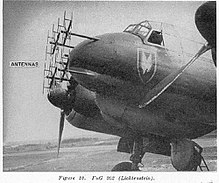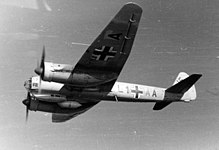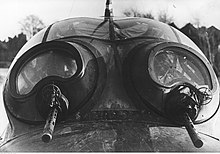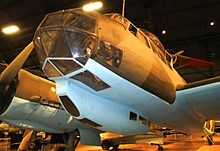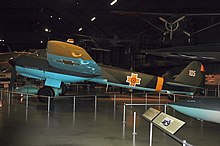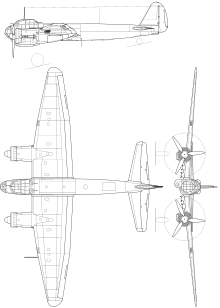Junkers Ju 88
The Ju 88 was envisioned to function as a so-called Schnellbomber ("fast bomber") that would evade interception by enemy fighters of its era by flying at high speed.
A series of technical problems troubled the aircraft's development, delaying its introduction to squadron service from 1938 to September 1939, by which point the Second World War had already started.
[2] The assembly line ran constantly from 1936 to 1945, building in excess of 15,000 Ju 88s across dozens of variants, making it the most-produced twin-engine German aircraft of the period and the second-most produced bomber of all time behind the four-engined Consolidated B-24 Liberator.
However, in August 1935, the RLM revised its requirements towards the concept of a Schnellbomber, a high-speed bomber that lacked defensive turrets, seated a crew of three, and carried a payload of 800–1,000 kg (1,800–2,200 lb).
[5] The first two prototypes, Ju 88 V1 and V2, differed from the V3, V4 and V5 in that the latter three models were equipped with three defensive armament positions to the rear of the cockpit, and were able to carry two 1,000 kg (2,200 lb) bombs, one under each inner wing panel.
[11] The third prototype, Ju 88 V3, which made its first flight on 13 September 1937 and was the first to be powered by the Jumo 211A engine, participated in a series of extensive tests at the Rechlin experimental station.
According to the aviation authors J.R. Smith and Antony Kay, the results of this evaluation were so positive that all work on the competing Henschel Hs 127 and Messerschmitt Bf 162 was abandoned quickly thereafter.
[12] Upon reviewing the Ju 88's performance, Hermann Göring, head of the Luftwaffe, was reportedly ecstatic; it was allegedly viewed as an aircraft that could finally fulfil the promise of the Schnellbomber.
[citation needed] The streamlined fuselage was modelled after its contemporary, the Dornier Do 17, but furnished with fewer defensive guns as a result of the belief still held that it could outrun late 1930s-era fighters.
The Ju 88 V7 was fitted with cable-cutting equipment to combat the potential threat of British barrage balloons, and was successfully tested in this role; the V7 also had the Ju 88 A-1 "beetle's eye" faceted nose glazing installed, complete with the Bola undernose ventral defensive machine gun emplacement, and was put through a series of dive-bombing tests with 250 and 500 kg (550 and 1,100 lb) bombs, and in early 1940, with 1,000 kg (2,200 lb) bombs.
As a reaction to the increasing number of attacks on German shipping, especially on U-boats in the Bay of Biscay, from July 1942 it started flying anti-shipping patrols and escort missions from bases in France.
[27] Some Ju 88 variants were also used as radio controlled bombs in the Mistel composite aircraft configuration, by coupling a bomber filled with explosive with a fighter such as the Focke-Wulf Fw 56 or the Messerschmitt Bf 109E.
The Ju 88P was a specialized variant for ground attack and to function as a bomber destroyer, designed starting from 1942[28] and produced in small numbers, using examples of the Bordkanone heavy calibre aviation autocannon series, which required the omission of the Bola undernose gondola for clearance.
[30] The Ju 88C was originally intended as a fighter-bomber and heavy fighter by adding fixed, forward-firing guns to the nose while retaining some bomb carrying ability of the A-series bomber.
The aircraft retained the ventral Bola gondola under the crew compartment though individual units sometimes removed this to reduce weight and drag to enhance performance.
Several C-6 night fighters were equipped with two "Schräge-Musik" upward-firing 20 mm (0.79 in) cannons in trial fittings, and from mid 1943 onward, there was an official field modification kit available for this arrangement.
A small number of the C-series day fighters had their new solid-metal noses specially painted to resemble the bomber A-series' "beetle's eye" faceted clear view nose glazing, in an attempt to deceive Allied pilots into thinking the fighters were actually bombers; the unusual "camouflage" attempt did result initially in a number of Allied aerial losses.
The Luftwaffe learned of this defection only the following month when members of the crew, pilot Oberleutnant Heinrich Schmitt (son of the former secretary to the ministry for foreign affairs (1923–1929) Gustav Stresemann) and Oberfeldwebel Paul Rosenberger made broadcasts on British radio.
The G-series fuselage was purpose-built for the special needs of a night fighter, with the A-series' Bola ventral under-nose defensive gun position omitted for lower aerodynamic drag and less weight, and adding the enlarged squared-off vertical fin/rudder tail unit of the Ju 188.
[37][38] G-6 versions were equipped with 1,287 kW (1,726 hp) Jumo 213A inverted V-12 engines (using the same redesigned annular radiator cores as the Ju 188s powered by them), enlarged fuel tanks and often one or two 20 mm (0.79 in) MG 151/20 cannons in a Schräge Musik ("Jazz Music", i.e. slanted) installation.
Only a very few Ju 88G-6 night fighters were ever fitted with the semi-experimental FuG 240 Berlin N-1 cavity magnetron based, 3 GHz-band (centimetric) radar, whose dish antenna was housed in a smoothly contoured radome on the G-6's nose.
[46] On 17 June 1940, Ju 88s (mainly from Kampfgeschwader 30) destroyed a "10,000 tonne ship", the 16,243 grt ocean liner RMS Lancastria, off Saint-Nazaire, killing some 5,800 Allied personnel.
[41] Some 133 Ju 88s were pressed into the Blitzkrieg, but very high combat losses (as well as accidents) forced a quick withdrawal from action to re-train crews to fly this very high-performance aircraft.
[57] In late April, in an attempt to disrupt preparations for the D-Day landings, Ju 88s were redirected towards British ports along the southern coast; these were largely ineffective and thus were abandoned within the space of a month.
That same month, the type was also used during the German invasion of Greece (Operation Marita); at the start of the conflict, several Ju 88s dropped mines along the approaches to the harbour of Piraeus and bombed ships in the vicinity, which took the port out of action for weeks.
[citation needed] On 22 June 1941, the invasion commenced; the Ju 88 units met with instant success, attacking numerous enemy airfields and positions at low level and causing enormous losses for little damage in return.
[68] Ju 88 units operating over the Baltic states during the battle for Estonia inflicted severe losses on Soviet shipping, with the same dive-bombing tactics used over Norway, France and Britain.
The attacking force lost one aircraft; the Allies had not assigned any fighters to guard Bari as they thought the Luftwaffe incapable of striking in this strength at this stage of the war.
Night fighter, new fuselage with A-series' ventral Bola (Bodenlafette) gondola omitted, tail section from Ju 188, aerodynamically improved conformal gun pod for a quartet of forward-firing 20 mm (0.787 in) calibre, MG 151/20 autocannons below the former bomb bay.
High-speed bomber series based on Ju 88 A-4 but with ventral Bola gondola omitted, smoothly glazed nose with radial-ribbed supports instead of the "beetle's eye" of the A-version, and GM-1 nitrous-oxide boost, fastest of all variants.







